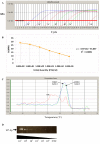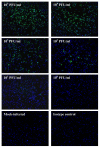Establishment of one-step SYBR green-based real time-PCR assay for rapid detection and quantification of chikungunya virus infection
- PMID: 20092632
- PMCID: PMC2827404
- DOI: 10.1186/1743-422X-7-13
Establishment of one-step SYBR green-based real time-PCR assay for rapid detection and quantification of chikungunya virus infection
Abstract
Chikungunya virus (CHIKV) is a mosquito-borne alphavirus and one of the prevalent re-emerging arbovirus in tropical and subtropical regions of Asia, Africa, and Central and South America. It produces a spectrum of illness ranging from inapparent infection to moderate febrile illness as well as severe arthralgia or arthritis affecting multiple joints. In this study, a quantitative, one-step real-time SYBR Green-based RT-PCR system for the non-structural protein 2 (nsP2) of CHIKV that can quantify a wide range of viral RNA concentrations was developed. Comparisons between the conventional semi-quantitative RT-PCR assay, immunofluorescence detection method and the one-step SYBR Green-based RT-PCR assay in the detection of CHIKV infection revealed much rapid and increase sensitivity of the latter method. Furthermore, this newly developed assay was validated by in vitro experiments in which ribavirin, a well-known RNA virus inhibitor, showed a dose-dependent inhibition of virus replication on cells that was assessed by viral infectivity and viral RNA production. Our results demonstrate the potential of this newly developed one-step SYBR Green I-based RT-PCR assay may be a useful tool in rapid detection of CHIKV and monitoring the extent of viral replication possibly in patients' samples.
Figures



Similar articles
-
Development and evaluation of SYBR Green I-based one-step real-time RT-PCR assay for detection and quantification of Chikungunya virus.J Clin Virol. 2007 Jul;39(3):188-93. doi: 10.1016/j.jcv.2007.04.015. Epub 2007 Jun 5. J Clin Virol. 2007. PMID: 17553740
-
Rapid detection and quantification of Chikungunya virus by a one-step reverse transcription polymerase chain reaction real-time assay.Am J Trop Med Hyg. 2007 Sep;77(3):521-4. Am J Trop Med Hyg. 2007. PMID: 17827371
-
Development and evaluation of a one-step SYBR-Green I-based real-time RT-PCR assay for the detection and quantification of Chikungunya virus in human, monkey and mosquito samples.Trop Biomed. 2010 Dec;27(3):611-23. Trop Biomed. 2010. PMID: 21399603
-
Rapid and real-time detection of Chikungunya virus by reverse transcription loop-mediated isothermal amplification assay.J Clin Microbiol. 2007 Feb;45(2):351-7. doi: 10.1128/JCM.01734-06. Epub 2006 Nov 29. J Clin Microbiol. 2007. PMID: 17135444 Free PMC article.
-
Chikungunya virus infection.Med J Malaysia. 2006 Jun;61(2):264-9. Med J Malaysia. 2006. PMID: 16898330 Review.
Cited by
-
A metagenomic survey of viral abundance and diversity in mosquitoes from Hubei province.PLoS One. 2015 Jun 1;10(6):e0129845. doi: 10.1371/journal.pone.0129845. eCollection 2015. PLoS One. 2015. PMID: 26030271 Free PMC article.
-
Maxizyme-mediated suppression of chikungunya virus replication and transmission in transgenic Aedes aegypti mosquitoes.Front Microbiol. 2023 Dec 22;14:1286519. doi: 10.3389/fmicb.2023.1286519. eCollection 2023. Front Microbiol. 2023. PMID: 38188571 Free PMC article.
-
Two types of nanoparticle-based bio-barcode amplification assays to detect HIV-1 p24 antigen.Virol J. 2012 Aug 31;9:180. doi: 10.1186/1743-422X-9-180. Virol J. 2012. PMID: 22935171 Free PMC article.
-
A polarized cell model for Chikungunya virus infection: entry and egress of virus occurs at the apical domain of polarized cells.PLoS Negl Trop Dis. 2014 Feb 20;8(2):e2661. doi: 10.1371/journal.pntd.0002661. eCollection 2014 Feb. PLoS Negl Trop Dis. 2014. PMID: 24587455 Free PMC article.
-
Establishment of a Novel Primary Human Skeletal Myoblast Cellular Model for Chikungunya Virus Infection and Pathogenesis.Sci Rep. 2016 Feb 19;6:21406. doi: 10.1038/srep21406. Sci Rep. 2016. PMID: 26892458 Free PMC article.
References
-
- Jupp PG, McIntosh BM. In: The arboviruses: epidemiology and ecology 2. Monath TP, editor. CRC Press, Boca Raton; 1988. Chikungunya virus disease; pp. 137–157.
-
- Griffin DE. In: Fields' Virology. Knipe DM, Howley PM, editor. Lippincott, Williams and Wilkins, Philadelphia; 2001. Alphaviruses; pp. 917–962.
Publication types
MeSH terms
Substances
LinkOut - more resources
Full Text Sources
Other Literature Sources
Medical

